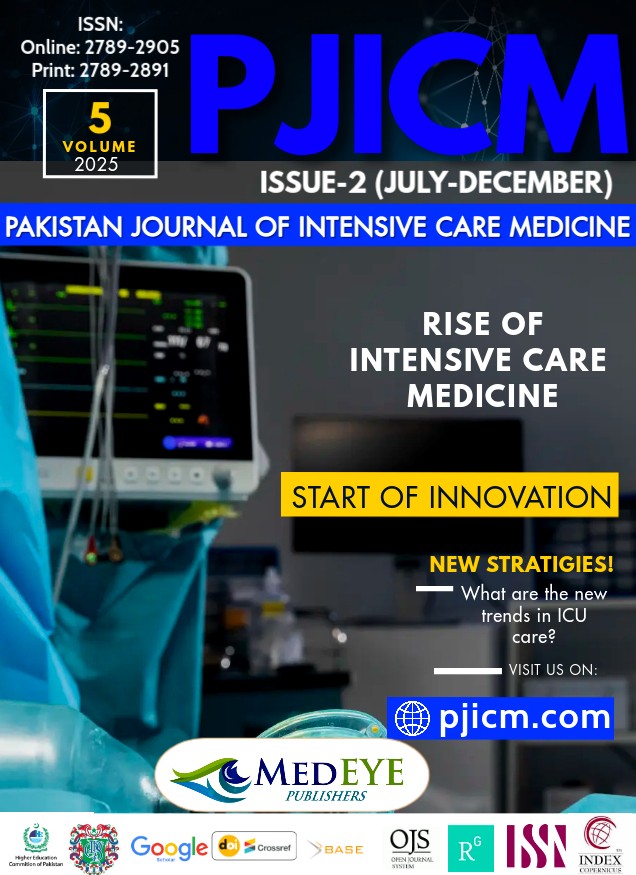EFFECT OF LOW DOSE ASPIRIN IN PREVENTION OF SPONTANEOUS PRETERM LABOUR
DOI:
https://doi.org/10.54112/pjicm.v5i02.187Keywords:
Low-Dose Aspirin, Spontaneous Preterm Labor, Preterm Birth, High-Risk PregnancyAbstract
Background: Preterm birth remains a significant cause of neonatal morbidity and mortality worldwide. Preventive strategies in high-risk pregnancies are crucial to improving perinatal outcomes. Low-dose aspirin, with its antiplatelet and anti-inflammatory effects, has been proposed to reduce the risk of preterm delivery when added to standard care. Objective: To evaluate the outcome of low-dose aspirin versus placebo in addition to the standard treatment protocol in high-risk pregnant women for preterm birth. Study Design: Randomised controlled trial. Setting: Department of Obstetrics and Gynecology III at Services Hospital, Lahore, Pakistan. Duration of Study: From 22-June-2024 to 22-April-2025. Methods: A total of 382 pregnant women aged 18–45 years with a history of prior preterm delivery were enrolled and randomized into two groups. Group A received low-dose aspirin (75 mg/day from 14–36 weeks of gestation) plus standard care (including progesterone therapy and infection management), while Group B received a placebo plus standard care. The primary outcome was the incidence of spontaneous preterm birth (<37 weeks of gestation). Statistical analysis was performed using SPSS version 23, and p < 0.05 was considered significant. Results: The mean age of participants was 28.79 ± 7.28 years in Group A and 29.08 ± 7.33 years in Group B. The incidence of spontaneous preterm birth was significantly lower in the aspirin group (9.4%) compared to the placebo group (17.8%) (p = 0.01). Conclusion: Low-dose aspirin, when administered in addition to standard therapy, significantly reduces the incidence of spontaneous preterm birth in high-risk pregnant women. This suggests a beneficial role for aspirin prophylaxis in improving perinatal outcomes among women with a history of preterm delivery.
References
Honest H, Forbes CA, Durée KH, Norman G, Duffy SB, Tsourapas A, et al. Screening to prevent spontaneous preterm birth: systematic reviews of accuracy and effectiveness literature with economic modelling. Health Technol Assess. 2009;13(43). https://doi.org/10.3310/hta13430
Lamont RF. Setting up a preterm prevention clinic: a practical guide. BJOG. 2006;113(Suppl 3):86–92. https://doi.org/10.1111/j.1471-0528.2006.01130.x
Lockwood CJ, Senyei AE, Dische MR, Casal D, Shah KD, Thung SN, et al. Fetal fibronectin in cervical and vaginal secretions defines a patient population at high risk for preterm delivery. N Engl J Med. 1991;325(10):669–74. https://doi.org/10.1056/NEJM199109053251001
Gomez R, Galasso M, Romero R, Mazor M, Sorokin Y, Gonçalves L, et al. Ultrasonographic examination of the uterine cervix is better than cervical digital examination as a predictor of the likelihood of premature delivery in patients with preterm labor and intact membranes. Am J Obstet Gynecol. 1994;171(4):956–64. https://doi.org/10.1016/0002-9378(94)90014-0
Berghella V, Hayes E, Visintine J, Baxter JK. Fetal fibronectin testing for reducing the risk of preterm birth. Cochrane Database Syst Rev. 2008;2008(4):CD006843. https://doi.org/10.1002/14651858.CD006843.pub2
Thoirs K, O’Hara S, Quinton A, Coombs P, Srayko S, Spurway J, et al. Ultrasound assessment of the gravid cervix to assess for risk of spontaneous preterm birth: introducing an evidence-based clinical guideline for sonographers. Sonography. 2024;11(2):113–25. https://doi.org/10.1002/sono.12424
Wikström T, Hagberg H, Jacobsson B, Kuusela P, Wesström J, Lindgren P, et al. Effect of second-trimester sonographic cervical length on the risk of spontaneous preterm delivery in different risk groups: a prospective observational multicenter study. Acta Obstet Gynecol Scand. 2021;100(9):1644–55. https://doi.org/10.1111/aogs.14203
Silver RM, Ahrens K, Wong LF, Perkins NJ, Galai N, Lesher LL, et al. Low-dose aspirin and preterm birth: a randomized controlled trial. Obstet Gynecol. 2015;125(4):876–84. https://doi.org/10.1097/AOG.0000000000000736
Allshouse AA, Jessel RH, Heyborne KD. The impact of low-dose aspirin on preterm birth: secondary analysis of a randomized controlled trial. J Perinatol. 2016;36(6):427–31. https://doi.org/10.1038/jp.2016.3
van Vliet EOG, Askie LA, Mol BWJ, Oudijk MA. Antiplatelet agents and the prevention of spontaneous preterm birth: a systematic review and meta-analysis. Obstet Gynecol. 2017;129(2):327–36. https://doi.org/10.1097/AOG.0000000000001848
Andrikopoulou M, Purisch SE, Handal-Orefice R, Gyamfi-Bannerman C. Low-dose aspirin is associated with reduced spontaneous preterm birth in nulliparous women. Am J Obstet Gynecol. 2018;219(4):399.e1–399.e9. https://doi.org/10.1016/j.ajog.2018.06.011
Visser L, de Boer MA, de Groot CJ, Nijman TA, Hemels MA, Bloemenkamp KWM, et al. Low-dose aspirin in the prevention of recurrent spontaneous preterm labour—the APRIL study: a multicenter randomized placebo-controlled trial. BMC Pregnancy Childbirth. 2017;17(1):147. https://doi.org/10.1186/s12884-017-1338-0
Ibrahim ZM, Mohamed ML, Gadallah AM, Mahmoud ES, Shora HA. Low-dose aspirin in the prevention of spontaneous preterm birth in Suez Canal University Hospital. Madridge J Intern Emerg Med. 2019;3(2):146–51. https://doi.org/10.18689/mjiem-1000133
Mirzamoradi M, Dehghani Z, Azadi P, Mohammadi M, Khavandegar A, Bakhtiyari M. Evaluation of the effect of low-dose aspirin on the prevention of preterm delivery in women with a history of spontaneous preterm delivery. Rev Bras Ginecol Obstet. 2023;45(11):e646–e653. https://doi.org/10.1055/s-0043-1772480
Kupka E, Hesselman S, Hastie R, Lomartire R, Wikström AK, Bergman L. Low-dose aspirin use in pregnancy and the risk of preterm birth: a Swedish register-based cohort study. Am J Obstet Gynecol. 2023;228(3):336.e1–336.e9. https://doi.org/10.1016/j.ajog.2022.09.006
Landman AJEMC, de Boer MA, Visser L, Nijman TA, Hemels MA, Naaktgeboren C, et al. Evaluation of low-dose aspirin in the prevention of recurrent spontaneous preterm labour (the APRIL study): a multicentre, randomised, double-blinded, placebo-controlled trial. PLoS Med. 2022;19(2):e1003892. https://doi.org/10.1371/journal.pmed.1003892
Downloads
Published
How to Cite
Issue
Section
License
Copyright (c) 2025 S MAQSOOD , R FARRUKH

This work is licensed under a Creative Commons Attribution-NonCommercial 4.0 International License.












